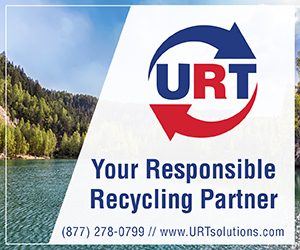 The debate over the merits and pitfalls of e-scrap exporting has been alive and well for decades now, but one thing has remained clear: Choosing to ship material halfway around the world adds a thick layer of complication to the basic goal of managing the domestic e-scrap stream.
The debate over the merits and pitfalls of e-scrap exporting has been alive and well for decades now, but one thing has remained clear: Choosing to ship material halfway around the world adds a thick layer of complication to the basic goal of managing the domestic e-scrap stream.
“It’s incredibly difficult for a recycler to figure out what’s legal and what’s not,” said Kelley Keogh, managing director at auditing and consulting firm Greeneye Partners.
Whether navigating the intricacies of regulations originally crafted in the mid-1970s or attempting to get a handle on the policies of foreign countries, U.S. e-scrap firms face a dizzying array of questions when it comes to shipping material overseas. And while many publicly disavow the practice of exporting, much of the industry relies on it.
“If you’re a smaller recycler, you might not be that involved with the export side of things, but if you’re a little bit larger and you have plastics and boards and CRT glass that has to get somewhere, then you have to be looking at exports,” said Jason Linnell, executive director of the National Center for Electronics Recycling (NCER).
The subject is also getting renewed interest as supporters of a federal bill that would reshape export law say progress is being made and a Congressional hearing could be on the way. First introduced in 2016, the legislation, known as the Secure E-Waste Export and Recycling Act (SEERA), requires firms to process devices before shipping material overseas.
In the first segment of “Eye on Exports,” a series of stories on the wide-ranging and emotionally charged topic of e-scrap exports, E-Scrap News reached out to a number of industry figures to get a handle on where U.S. law and regulations come down on the practice and how processors are navigating thorny questions of legality.
In the coming weeks, additional articles will cover how certifications and international law are further shaping export expectations. The goal of the series is to help electronics recovery stakeholders clearly understand the policies, market forces and societal implications that are shaping the way material flows around the globe.
Legality up for debate
To get the conversation started, it’s helpful to get a grasp on how e-scrap shipments to foreign countries are covered by U.S. regulations currently on the books. With pressure continuing to mount on companies to be transparent about their export practices, stakeholders have searched for cut-and-dry descriptions in federal policy.
But what’s actually legal from a U.S. standpoint is essentially a matter of interpretation.
“It’s a complicated process to determine whether or not something is a waste, whether it’s hazardous and whether it can be legally exported,” explained Corey Dehmey, R2 director at Sustainable Electronics Recycling International (SERI), which administers the R2 electronics recycling standard. “There are domestic regulations under RCRA and then on top of that, there’s the multilateral treaty under the OECD.”
RCRA, the abbreviation for the Resource Conservation and Recovery Act, is the best place to start to try to get a handle on relevant U.S. policy. Passed in 1976, RCRA set out to define solid and hazardous wastes in the U.S. and provide “explicit, legally enforceable requirements for waste management.” Over the years, RCRA regulations have been updated to cover a number potentially hazardous materials, including various types of e-scrap, and it spells out specific exporter requirements for these materials.
But one of the inherent complexities of RCRA is that it’s up to generators to make a determination on whether a shipment is considered a hazardous waste. To do so, the law notes generators must assess the material in question for ignitability, corrosivity, reactivity and toxicity. For instance, if lead content exceeds 5 milligrams per liter or if mercury content exceeds 0.2 milligrams per liter, the material is considered hazardous.
This means many firms hire advisors to assist in the determination process and to provide support in navigating the additional intricacies of international law.
“Due to the complexity of export laws and international regulations, we have a team of consultants that help us navigate through all the different regulations and requirements regarding exports,” said Aaron Blum, chief operating officer and compliance officer at Fresno, Calif.-headquartered processor ERI. “This is due to the challenging nature of trying to navigate through it ourselves and has been for many years.”
In the event a potential shipment is found to be hazardous, various additional controls and costs come into play that hamper — and often prevent — firms from utilizing the export market.
That said, the general consensus is that e-scrap, including scrap commodities and whole devices bound for recycling and reuse, is often interpreted as being non-hazardous by the industry. While there is no overarching hazardous waste exclusion for scrap electronics under RCRA, many kinds of e-scrap pass hazardous waste testing protocols or are covered by various recycling exclusions that have been built into RCRA-related regulations, including for CRTs, circuit boards, scrap metal and batteries. As long as they’re followed closely, these exemptions allow the industry at large to treat potentially problematic material, such as lead-laden CRT glass, as non-hazardous.
“My understanding is that RCRA is very limited in the scope of e-scrap it regulates in export and it is also limited in its reach,” said Neil Peters-Michaud, CEO of Cascade Asset Management (CAM), a Wisconsin-based processor.
OECD Control System comes into play
But Peters-Michaud and many others also note another key consideration when it comes to U.S. export law: the OECD Control System for Waste Recovery.
Because the U.S. is a member of Organisation for Economic Co-operation and Development (OECD), U.S. companies are legally bound to follow additional export controls when shipping material to other OECD countries. The U.S. EPA adopted these rules in late 2016.
Under the OECD Control System, scrap materials bound for another OECD country are considered “green” and not subject to additional controls only if they “present low risk for human health and the environment.” However, those that present “sufficient risk to justify their control” are referred to as “amber” and are subject to a range of additional measures.
According to the guidance document, “amber” wastes shipped to another OECD country require companies to notify the U.S. government and the countries of “transit” and “import.” Companies must also receive consent to proceed with the shipment and maintain documentation and proof of recycling.
While the multi-national agreement regards “electronic scrap (e.g. printed circuit boards, electronic components, wire, etc.) and reclaimed electronic components suitable for base and precious metal recovery” as a “green” waste, toxic substances commonly found in e-scrap, including mercury and lead, can make the material subject to “amber” controls.
Once again, however, it’s up to recycling companies and their partners to determine what’s “green” and what’s “amber.” What’s more, these controls do not impact shipments of material to non-OECD countries, meaning that if RCRA indicates a shipment is non-hazardous, it’s often viewed as legal – from a U.S. standpoint – to move the material to non-OECD countries.
There are a total of 35 OECD countries today, including Canada, Mexico, Australia, much of Europe, Japan, Korea and Israel. Non-OECD countries include China, India and Brazil and developing economies in Africa, Asia, Latin America and the Caribbean.
Industry weighs in and looks ahead
The combination of RCRA and OECD controls often results in challenging legal considerations for recycling companies. E-scrap professionals note, however, that it’s international law that’s especially tricky to track.
“The complexity of navigating U.S. export law lies with understanding the regulations of the importing country,” said Mark Swenson, director of EH&S and compliance at Dynamic Recycling, a Wisconsin-headquartered ITAD and e-scrap recycling company.
Swenson said it’s “complicated to search, translate, and interpret international requirements,” and Dynamic has had to “recruit team members to build knowledge in this area to ensure continued compliance.”
One issue is the fact that the U.S. has not ratified the Basel Convention on the Control of Transboundary Movements of Hazardous Wastes and Their Disposal, an international treaty. The Basel Convention’s objective is to limit movement of hazardous waste from wealthy nations to poorer ones. The lack of ratification by the U.S. creates a number of difficult questions, most notably the following: To what degree does the Convention cover material shipped from the U.S. to a developing country that has ratified the treaty?
Jim Puckett, executive director of environmental watchdog group Basel Action Network (BAN), argued that current U.S. law is 25 years behind and leads to exports that often break the laws of importing countries.
“This is a glaring affront to global responsibility and environmental justice,” Puckett said. “We have perpetuated a U.S. policy where we knowingly allow the violation of the laws of dozens of countries, including China, India, Malaysia and Vietnam.”
BAN’s e-Trash Transparency Project has documented a wide range of instances of U.S. exports in potential violation of international law. The group is continuing to press the U.S. government, including the U.S. EPA, to reshape its export policy. Puckett noted the EPA “has been grossly negligent in their lack of response to the well-documented toxic trade abuse perpetrated by U.S. companies – a trade that violates the laws of importing countries, international laws and norms.”
A U.S. EPA spokesperson declined to comment for this story.
Advocates for stricter export controls argue that most exports are going overseas to non-OECD countries, making the additional “amber” controls of the OECD Control System a non-factor.
Bob Houghton, the CEO of Sage Sustainable Electronics, an Ohio-based electronics recycling and refurbishment company, told E-Scrap News many processors in the U.S. are filling shipping containers with potentially toxic material, such as mercury-containing LCD scrap, and sending them overseas.
“A lot of people that say they don’t export are, in fact, exporting and, of course, there are many people that don’t claim one way or another how they’re handling material and those folks in almost every case are exporting,” Houghton added.
Others, however, believe RCRA and the controls in place adequately handle environmental concerns while protecting free trade. The Institute of Scrap Recycling Industries (ISRI) has regularly expressed this viewpoint.
“The U.S. is a capitalist market economy and scrap commodities, including electronic scrap, are bought and sold in an open marketplace,” said Adina Renee Adler, senior director of international relations at ISRI. “While we understand that the U.S. government has policies in place for the movement of hazardous materials, in general our core policy is free and fair trade – and free and fair trade is governed by the marketplace and not by government policy.”
Legislation in Congress
Some U.S. e-scrap representatives, hoping to convince U.S. lawmakers to address the export issue in clearer terms, helped develop the SEERA legislation that was introduced to Congress in both 2016 and 2017. The bill failed to gain traction both times (and similar legislation also died in Congress several years earlier), but supporters say they are not giving up on the policy push.
Championed by the Coalition for American Electronics Recycling (CAER), SEERA would not altogether ban exports, as previous legislative proposals have attempted to do. The bill, which is also being supported by BAN, requires companies to process material before shipping it overseas. It has been framed as an effort to combat counterfeiting operations abroad that are viewed as a threat to national security.
“We’ve got over 140 members now and everybody in the coalition has agreed on the notion that we want to process e-waste before it is exported,” said Houghton, who also serves as a founder and member of CAER. “We’re all very pro-export, but we want to end the practice of just stuffing shipping containers with anything and everything and seeing them disappear for a certain number of cents per pound. We want domestic processing and that’s what we continue to work on.”
CAER is pushing for a hearing in the near future, Houghton said, and it has “good traction” in the effort. “I invite ISRI to join CAER in calling for a hearing and make their case,” Houghton said. “It will provide for a full and thorough debate on the issues.”
For its part, ISRI said proposed U.S. laws, including SEERA, greatly overstate the problem of exports. “Those bills have never passed because the facts haven’t lined up,” said Billy Johnson, ISRI’s director of political and public affairs.
As for the prospects of any export bill moving forward, Linnell at NCER said it’s possible something will eventually get passed, but that the industry remains fairly divided on the issue.
“The landscape is much different than it was 10 or 15 years ago when there were calls for outright export bans,” he noted. “The proposals themselves have become a lot more tailored to the things we’re OK with happening and the conditions.”
Linnell also stressed that the industry finds itself reliant on exports, however complex that landscape is to navigate from a legal point of view.
“There is a lot that needs to go overseas and that is going overseas right now,” he said. “You’ve got to make sure that can continue to happen as long as the markets have been verified and there’s been due diligence.”



